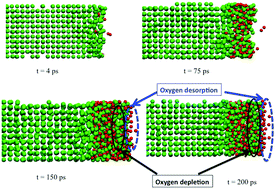Considerations on ultra-high frequency electric field effects on oxygen vacancy concentration in oxide thin films
Abstract
Atomistic simulations employing dynamic charge transfer between atoms are used to investigate ultra-thin

* Corresponding authors
a
Center for Nanoscale Materials, Argonne National Laboratory, Argonne, USA
E-mail:
skrssank@anl.gov
b Nuclear Engineering Division Argonne National Laboratory, Argonne, IL 60439, USA
c Harvard School of Engineering and Applied Sciences, Harvard University, Cambridge, MA 02138, USA
Atomistic simulations employing dynamic charge transfer between atoms are used to investigate ultra-thin

 Please wait while we load your content...
Something went wrong. Try again?
Please wait while we load your content...
Something went wrong. Try again?
S. K. R. S. Sankaranarayanan, R. Subbaraman and S. Ramanathan, Phys. Chem. Chem. Phys., 2012, 14, 3360 DOI: 10.1039/C2CP22696K
To request permission to reproduce material from this article, please go to the Copyright Clearance Center request page.
If you are an author contributing to an RSC publication, you do not need to request permission provided correct acknowledgement is given.
If you are the author of this article, you do not need to request permission to reproduce figures and diagrams provided correct acknowledgement is given. If you want to reproduce the whole article in a third-party publication (excluding your thesis/dissertation for which permission is not required) please go to the Copyright Clearance Center request page.
Read more about how to correctly acknowledge RSC content.
 Fetching data from CrossRef.
Fetching data from CrossRef.
This may take some time to load.
Loading related content
